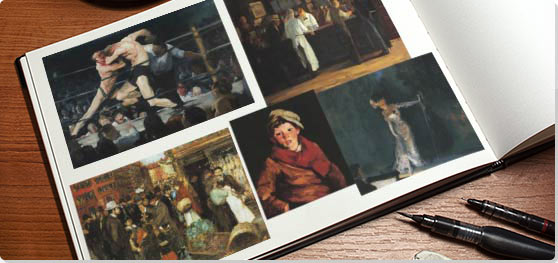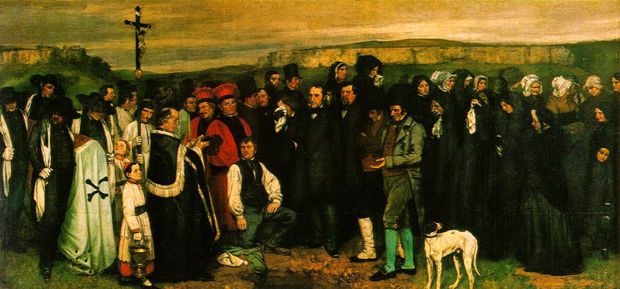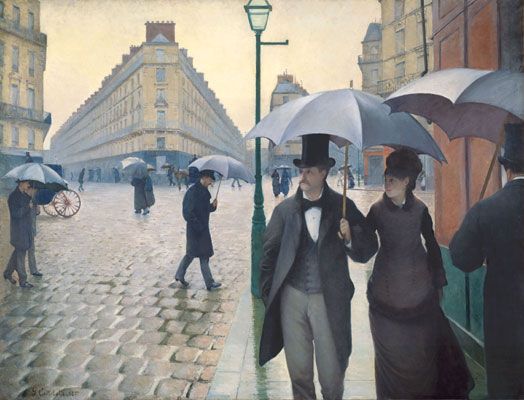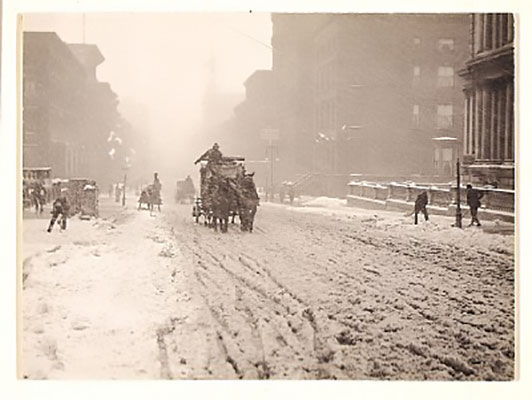Summary of Ashcan School
Known for its gritty urban subject matter, dark palette, and gestural brushwork, the Ashcan School was a loosely knit group of artists based in New York City who were inspired by the painter Robert Henri. The group believed in the worthiness of immigrant and working-class life as artistic subject matter and in an art that depicted the real rather than an elitist ideal. While their subject matter was revolutionary, their manner of painting finds precedents in the Realism of 17th-century Spanish and Dutch art, and also with 19th-century French painting. In the United States, prior to the arrival of the Ashcan School, American Impressionism, with its pleasing and luscious displays of the feminine and peaceful idylls, held sway. After the Ashcan School, more artists focused on modernity and their own expressive reactions to what they encountered. Their main achievement was to reverse the formula of previous New York painters by focusing on the dynamic energy of the people. Yet, with the arrival of European modernism to New York via the Armory Show (1913), the Ashcan School was retrograde in comparison.
Key Ideas & Accomplishments
- Henri and the other painters pursued authenticity in art, a quality associated with direct experience, immediacy of execution, and a new emphasis on the truth and validity of one's first impression. This resulted in canvases which portray a sense of haste and liveliness, of the working people of New York, and of a release from the artist's need to create beauty from the extraordinary.
- Modernism brought with it a new sense of the visual. Ashcan School artists were interested in new modes of seeing and being seen in modern New York City: people walking in parks, prostitutes on the street, artificial lights in boxing arenas and vaudeville reviews, a film projecting in a movie theater that illuminates the working-class audience, and the great proliferation of images due to advances in publishing and mass media.
- The Ashcan School artists rejected skillful, finished drawing and the ability to render the outward appearance of people and things and instead celebrated personal vision.
- The works' sketchy quality, vigorous paint application, and sense of reportage came from the artists' training as newspaper illustrators who captured the spectacle of the expanding modern metropolis. The artists sought new forms of Realism to describe the rapid and great changes in urban life, commercial culture, and codes of social contact.
Artworks and Artists of Ashcan School
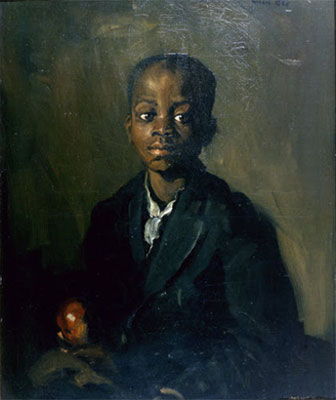
Portrait of Willie Gee (1904)
Willie Gee, an African-American boy of a tender age, is seated with an apple in hand and wearing rumpled clothing. The artist noted in his daybooks that Gee was the son of a woman who had been a slave in Virginia and had recently moved north. The nondescript, brushy background of browns and grays offers little commentary or details as to who Gee actually is and in its simplicity renders the young boy as quite humble. Henri's fluid brushwork, most noticeable on Gee's coat sleeve and white collar, is there to suggest the activity and movement one usually associates with young children. Traditionally the patrons of child portraiture were moneyed individuals who sought to celebrate their notable lineage or remember deceased children. There was no wealthy patron in this case, and Willie Gee was just a neighborhood child of the working class who appealed to the artist. Henri and his followers rarely ventured into New York's African-American neighborhoods, concentrating instead on the immigrant inhabitants of Lower Manhattan. Here, Henri breaks from the dominant stereotypes of African Americans then found in visual culture.
Oil on canvas - Newark Museum of Art, Newark, NJ

At Mouquin's (1905)
At Mouquin's remains Glackens' most celebrated and grand painting. In the foreground, the fashionable outerwear slung over the back of a chair leads our eye into the center of the painting where Glackens posed friends as elegant New Yorkers out on the town. The work's sophistication and psychological content in the woman's countenance prompted critics to compare Glackens to Édouard Manet. The clever use of mirrors to replicate and expand the special plane call to mind Manet's masterwork The Bar at the Folies Bergere (1881-82). While a young man in Paris, Glackens followed Henri's direction to seek out works by Manet. Here, Glackens turns his attention to new social spaces, such as this fancy restaurant, and new social relationships which reveal interior states (this was the era of Freud's initial publications on human psychology). We glance upon the woman's face, which is turned away from her jubilant partner and seems melancholy, if not weary, as she gazes off the canvas. As hers is the most forward visage in the composition, we connect most with this woman and her seeming isolation.
Oil on canvas - The Art Institute of Chicago
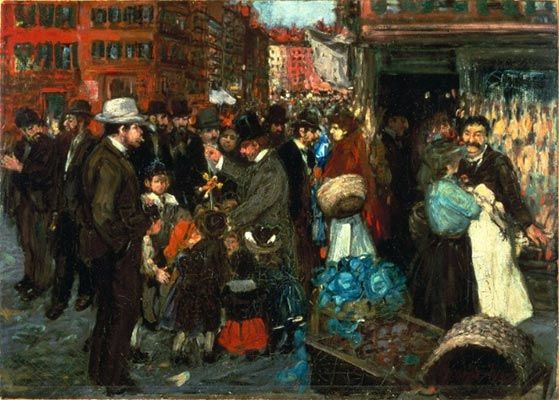
Hester Street (1905)
In 1904, after a twenty-year extended sojourn away from his native country, famed novelist and essayist Henry James returned to his dramatically changed birthplace; where he went and what he observed culminated in his collection of essays The American Scene (1907). Appalled by the arriving European masses, James was frightened that the "hodgepodge" of racial characteristics they brought to the United States would dilute the true meaning of being an American. James wholehearted supported the primacy of white Anglo-Saxon Protestants, and viewed the Jews, the Italians, and the Irish as racial others and outsiders.
In contrast to James, Luks delighted in this culturally diverse urban sprawl jam packed with humanity, found on New York's Lower East Side. By 1905, the downtown streets were crowded with substandard tenements and were home to the Eastern-European Jews who had arrived on these shores by the hundreds of thousands. Luks, a rough and tough character himself, wholly embraced the busy chaos of this spectacle. Luks's method was to make quick sketches onsite, which he would use as the basis of his painting. The artist applied paint with a fluid, rapid brush in order to capture the energy of the scene. Here, Luks brings us into the swell of the crowds, rather than maintain a distance, which allows viewers to viscerally experience the mass of humanity that populated the poor neighborhoods of New York. Further, while Luks isolates ethnic and racial types within this canvas (note the bearded Jewish men at left with side locks), he does not give into cheap ethnic stereotypes which were so common at the time. The modernity and newness of the image comes through in its innovative subject matter (most artists turned away from the immigrant classes as subjects) and the air of excitement Luks conveys.
Oil on canvas - The Brooklyn Museum of Art
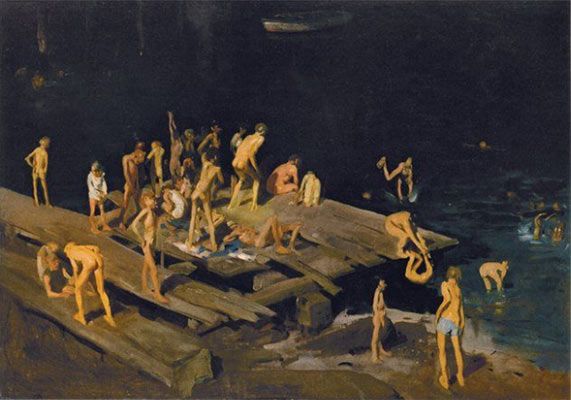
Forty-Two Kids (1907)
Forty-two boys or "kids" swim in the dirty waters of New York City's East River to escape the stifling heat of ill-ventilated tenement apartments. Under the dark cover of night at the city's edge, the boys use a modified dog paddle as their stroke to push floating garbage out of their way. George Bellows's brushy, rough application of oil paint marked the boys' social class onto their bodies, which are nude and scrawny. The term "kid" was popularized by the cartoon Hogan's Alley, whose protagonist was "The Yellow Kid," a slum-dwelling hooligan.
Bellows's depiction of city boys diving off splintered piers and reveling in their freedom, coupled with his bravura, painterly style appalled several New York art critics. One caustically appraised Bellows's canvas, asserting that "most of the boys look more like maggots than humans." While many similarly derisive words denigrated poor immigrants, the boys themselves are clearly enjoying their escape from society's scrutiny. Bellows's work typifies the Ashcan School artists' interest in everyday subject matter, the urban poor, and the overall vitality of life.
Oil on canvas - The National Gallery of Art, Washington DC
Footlight Flirtation (1912)
New York, the modern city, was home to many new and spectacular forms of and venues for entertainment. Some were outdoors such as Coney Island's fantastical Dreamland and its illuminated Luna Park, while others were indoors, such as movie theaters and restaurants. Shinn seized on the spectacle of the theater and vaudeville as his signature subjects, including this canvas, which shows the influence of the French Impressionists, in particular Edgar Degas's ballet and opera scenes of Paris. Shinn places us, his viewing audience, in the second row of seats just behind three women topped off with fancy hats. This device of locating his own viewers within the painting's setting is indebted to both Degas and Mary Cassatt. In vaudeville, attending audiences were attracted by the promise of a fleeting interaction with the stage performers. The coquettish young lady on stage gazes directly into the eyes of an audience member as she daringly lifts her skirt to reveal her shapely legs, which was quite daring for its time!
Oil on canvas - Private Collection
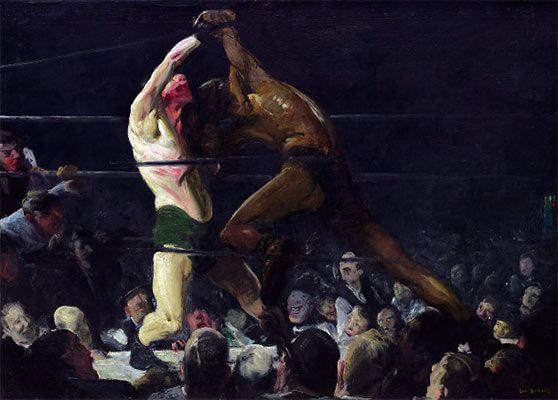
Both Members of this Club (1909)
Bellows, known for his manly swagger and bravado, played semipro baseball before relocating to New York City to study painting with Robert Henri. A late-comer to the satellite of artists surrounding Henri, Bellows is frequently considered part of the Ashcan School due to his technique and subject matter. Here, Bellows has packed so much energy and life into this boxing match that one can almost experience viscerally the power of a gloved fist upon bloodied flesh. The vibrancy of color application and fluid brushwork recall the influence of the 17th-century Dutch painter Franz Hals, whom Bellows greatly admired. Bellows affords us a ring-side view as we are situated as part of the gathered audience at this boxing match. While the name of the white boxer is unknown, the African-American boxer is Joe Gans, who would be the champion for eight years. Public boxing was illegal at sporting clubs due to its crass brutality, but memberships were granted for the duration of the boxers' bout in order to circumvent these restrictions. Hence the name of this work. Boxing was also highly racially charged as white America looked for its "Great White Hope" to conquer champion African-American Jack Johnson, the heavy weight champ. Bellows illuminates and distorts the faces of the spectators who surround the ring, openly mocking their elite status.
Oil on canvas - National Gallery of Art
McSorley's Bar (1912)
John Sloan's canvas McSorley's Bar is his visual commentary on male bonding, prohibition, drinking, and the working class. It typifies the Ashcan School's painterly style, depiction of the working class and immigrant communities (here, the Irish Americans), urban subject matter, and the Ashcan School's promotion of painting as a masculine enterprise. Sloan locates us, his audience, at tables just across from the bar depicted at center here in McSorley's Ale House established in 1854 and still operating today. Maintained as a male-only pub well into the late-20th century, Sloan invites all viewers into this gendered, public drinking spot. Sloan informally arranges the men both standing and working at the bar in a frieze-like formation as the light enters from the right to illuminate their faces and gestures. There is a roughness to how Sloan, a prominent illustrator, has applied the oil paint, which evokes the authenticity of the scene.
Oil on canvas - Detroit Institute of Art
Cover: The Masses (1914)
John Sloan was an active socialist and began to work for The Masses, a magazine published in bohemian Greenwich Village, soon after it was founded in 1911. Sloan contributed illustrations which were powerfully drawn, politically radical, and forthright in their socialist critique of inequality. There is a marked distinction between Sloan's assertion of his politics in his graphic works and how he approached his paintings as acts of social observation, but without a revolutionary agenda. As the artist stated, "While I am a Socialist, I never allowed social propaganda into my paintings."
Sloan's cover illustration here commemorates the Ludlow Massacre, when Colorado National Guard troops and Colorado Fuel & Iron Company camp guards attacked striking miners and their families in Ludlow, Colorado, in April 1914. Here, a roughly drawn miner shoots back at the troops who have murdered his family. This same image served as the cover of the International Socialist Review. In contrast to his oil paintings, which celebrated working class life without a political agenda, here, Sloan directly addresses, perhaps encourages, the class struggle. As surely as the miner points his gun at John D. Rockefeller's henchmen and the National Guard, the artist places blame on such robber barons as Rockefeller for the deaths of the honest workers and their families.
Printed paper
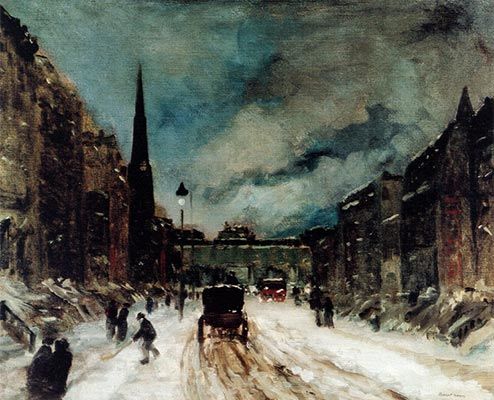
Snow Scene (57th Street) (1902)
Robert Henri does not romanticize the falling of snow on a busy metropolis such as Manhattan. As he pictures the well-traversed cityscape, the snow is grey and muddy with dirt while people huddle together as they plunge forward into the biting cold wind. In the hands of the American Impressionists, the group of moderns prior to the Ashcan School, the subject of snow blanketing the city would have concentrated on pastels, the reflective qualities of light, and air upon snow as it glistens. Henri also mixes old New York, through the horse drawn carriage at center, with modern technology such as the elevated train, which runs overhead.
Oil on canvas - Yale University Art Gallery
Beginnings of Ashcan School

At the turn of the last century, a group of young artists appeared who were set on challenging the refinement, polish, and idealistic American Impressionists who then dominated the art scene. Philadelphia's Robert Henri was the leader of the group which was made up of John Sloan, Everett Shinn, George Luks, and William Glackens. Each one varied in style and subject matter; yet, all were urban realists who adhered to Henri's motto "art for life's sake," rather than "art for art's sake." Despite their common economic and ethnic backgrounds, each approached the urban scene in a unique manner. Henri had studied at the Philadelphia Academy of Fine Art, as well as at Paris's Academie Julian. He began to mentor the four artists, all of whom were newspaper illustrators, circa 1892; we consider this grouping to be the first generation of Ashcan School painters. The second generation commenced with Henri's move to Manhattan and the inclusion of his New York student George Bellows.
The Eight is Formed
In 1908, the core Ashcan School artists were joined by three other painters, Edwin Lawson, Maurice Prendergast, and Arthur B. Davies, to form The Eight. This new formation only exhibited as a group once, at the MacBeth Galleries in New York. What united this varied grouping of artistic rebels was their opposition to the conservative and very powerful National Academy of Design's system of juried exhibitions. Henri and many other artists believed that the National Academy was not supportive of more liberal, modern ideas and was indifferent to their art. Opposing competitions and the selections of conservative juries, Henri advocated a no-jury, no-prize, open policy for exhibitions that he felt nurtured a creative atmosphere. The Eight was putting power back into the hands of the artists who selected the works, and its members designed the installation themselves.
The Radical Exhibitions of New York City
Sloan and Henri worked together with Davies and painter Walk Kuhn to assemble the 1910 Exhibition of Independent Artists (1910), America's counterpart to the Salon des Refusés in France. In Paris, the then-unpopular Impressionists came together to exhibit their work, which had been rejected by the official Salon organized by the French government and was met with harsh critical reaction; this served as a model for Henri's group. The 1910 Exhibition was a second attempt, after the exhibition at The MacBeth Galleries, to pull the presentation of art into the power of the artists. There was no jury, no prize system, and the works were hung alphabetically to encourage a democratic viewing. Almost five hundred works by over one hundred artists were displayed. Over two thousand people attended the opening night, and thousands more visited the three-week-long exhibition. It was a media sensation, but reviews were mixed, and only few works sold.
The Eight and the Armory Show
The single independent exhibition that had, and still resounds, the greatest influence on American art was the 1913 Armory Show, which expanded the ideas of the 1910 affair to an international exhibition by displaying great numbers of European modernist works. The exhibition ran in three cities, where a total of 250 thousand people visited it. Arthur B. Davies and Walt Kuhn were the key organizers of the Armory Show; Henri was minimally involved. In January 1912, a committee of twenty-five artists formed the Association of American Painters and Sculptors, which was the nucleus of the Amory Show of the following year. Most of the involved artists were either allied with the National Academy of Design or with Henri. Davies, of the Eight, was allied with both groups and was at the forefront of the exhibition. Glackens produced a listing of over one thousand American works for inclusion. Davies felt that the American aesthetic provincialism must be challenged; the artist was well-versed in European modernism. Kuhn travelled to Europe gathering works, a total of over four hundred, beginning with the French Romantic period. The show's viewpoint was overwhelmingly French modernism, which would direct the course of American art for generations. Attendance at the Armory Show was initially disappointedly low until vitriolic reviews were published that captured the public's fancy. At this point, people came in great numbers; many came merely to mock and make sport of the works on view, especially Marcel Duchamp's Nude Descending a Staircase. After New York, which drew the greatest crowds and reviews, the massive exhibition traveled to Boston and Chicago; the Chicago Vice Commission investigated supposedly immoral material on view, which served only to boost attendance. Students at the Art Institute of Chicago hung Constantin Brancusi and Henri Matisse in effigy. The Armory Show's immediate impact was the proliferation of galleries in New York City. Previously, in 1911, Alfred Stieglitz had exhibited some works by modernists at his 291 Gallery, but this did not equal the number of works on view at the Armory Show. American artists were interested in and influenced by Synethetic Cubism, which was exhibited in great number at the Armory. An additional consequence of the Armory Show was the creation of private venues such as the Mable Dodge Luhan and the Arensberg salons that became fertile grounds for discussions of modernism.
Ashcan School: Concepts, Styles, and Trends
The Sidewalks of New York
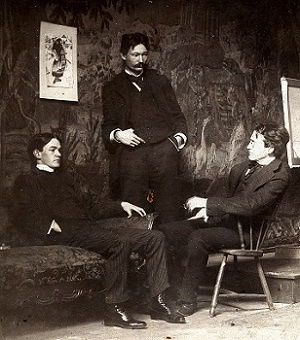
For such modernists as Lyonel Feininger and John Marin the excitement of bustling Manhattan was captured by looking up and depicting the magnificent skyscrapers that punctuated the skyline, such as the newly built Metropolitan Life and Woolworth buildings. But the Ashcan artists approached New York City at street level, tracking changing trends in immigration, advertisement, and popular entertainment. It has been said that Henri's group was less inclined to paint the city's new architecture than they were interested in the people who built such edifices. They emphasized the action on the street, peddlers, prostitutes, tourist spots, impoverished children, women strolling in newly built parks, and commuters, rather than the picturesque and distant panoramic views.
New York's Workers and Immigrants
As opposed to reformist photographers such as Jacob Riis, the Ashcan School artists were not interested in effecting social change but instead in capturing the vitality of urban life on many social levels. The newly arrived to America, such as the Southern Italians and Eastern-European Jews, held great fascination for native-born New Yorkers who travel on sightseeing tours of the Lower East Side to gasp and gape. Although the Ashcan School artists were not entirely immune to ethnic stereotyping, for example, the many hooked-nose Jews in Luks's Hester Street (1905), overall they sought to celebrate the city's diverse people and their ways of life in their canvases. The exception of an Ashcan artist that was concerned with social issues would be Sloan's graphics for The Masses, which were socialist in intent and sought to feed the workers' struggle against capitalism.
Spectacle and Dazzle: The Art of Entertainment
Mass production of consumer goods fostered leisure time for many New Yorkers who sought out the new spots and forms of entertainment that the city offered. The Ashcan School artists would follow suit with their canvases and sketchbooks. With supplies in hand, Henri and his followers would depict bloody boxing matches (Bellows), drinking establishments such as McSorley's (Sloan), and the picture shows and vaudeville performances (Shinn). But as still remains true today, the greatest theater in New York City is the theater of the streets, which commanded the Ashcan's greatest attention. Then, as now, New Yorkers liked not only to see, but also to be seen. Ashcan artists primarily dismissed the domestic sphere, which was the provenance of women, in order to engage with the rough streets and people of New York and with such social spheres as bars and gentlemen clubs, where women and minorities were prohibited.
Later Developments - After Ashcan School
Constituting the artistic avant-garde at this juncture, the Ashcan School, along with members of the Eight, played a crucial role in organizing the watershed Armory Show of 1913 that introduced American audiences to European modernism; it was this new and shocking European work that rapidly supplanted the Ashcan artists' claim of artistic radicalism. In contrast to the modern works of Pablo Picasso, Georges Braque, and others, the Ashcan School, with their tight hold on realism, looked absolutely provincial in comparison and soon became overshadowed. The same investment in the city and modernity that made the Ashcan School so current ironically contributed to its demise. Cameras and news photographs took on the task of reportage which had been the purview of the painters. The increase in photography, between the years 1910 and 1920, may have encouraged the artists to depart from their earlier styles and subject matter. Individually, each artist renounced urban subjects of daily life for stylistic experimentation and "pure art," meaning less socially charged art. By 1915, Henri adopted alternate color theories, resulting in the garish look of his late portraits. Glackens turned to Impressionism, painting such studio-based subjects as nudes and still lifes. Bellows left New York City behind and concentrated on seascapes and landscapes. During the 1920s, Sloan was based primarily in New Mexico, where he documented the lives and faces of the indigenous Americans. Each took on numerous students, several of whom formed the Fourteenth Street School in the 1920s. The influence of the Ashcan School's focus on urbanism, immigrants, and impoverished Americans resonates with the Social Realism movement of the 1930s and such artists as Ben Shahn and Edward Hopper.
Useful Resources on Ashcan School
- Painters of the Ashcan School: The Immortal EightOur PickBy Bennard B. Perlman
- Picturing the City: Urban Vision and the Ashcan SchoolBy Rebecca Zurier
- Life's Pleasures: The Ashcan Artists' Brush with Leisure, 1895-1925By James Tottis, Valerie Ann Leeds, Vincent Digirolamo, Marianne Doezema, and Suzanne Smeaton
- The Eight and American ModernismsOur PickBy Elizabeth Kennedy
- Metropolitan Lives: The Ashcan Artists and Their New York, 1897-1917By Virginia M. Mecklenburg, Robert W. Snyder, and Rebecca Zurier
- An American Experiment: George Bellows and the Ashcan PaintersBy David Peters Corbett
 Ask The Art Story AI
Ask The Art Story AI